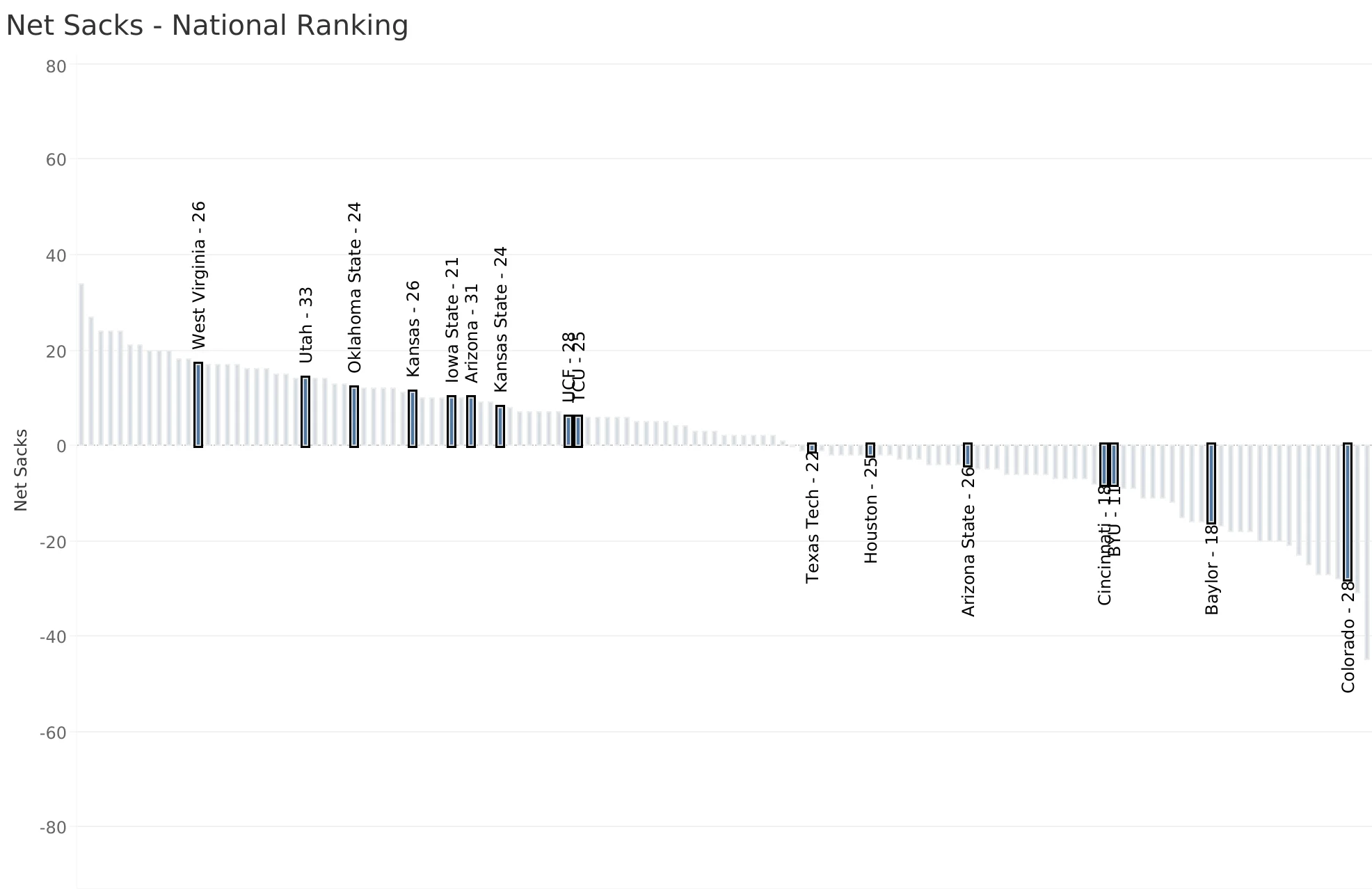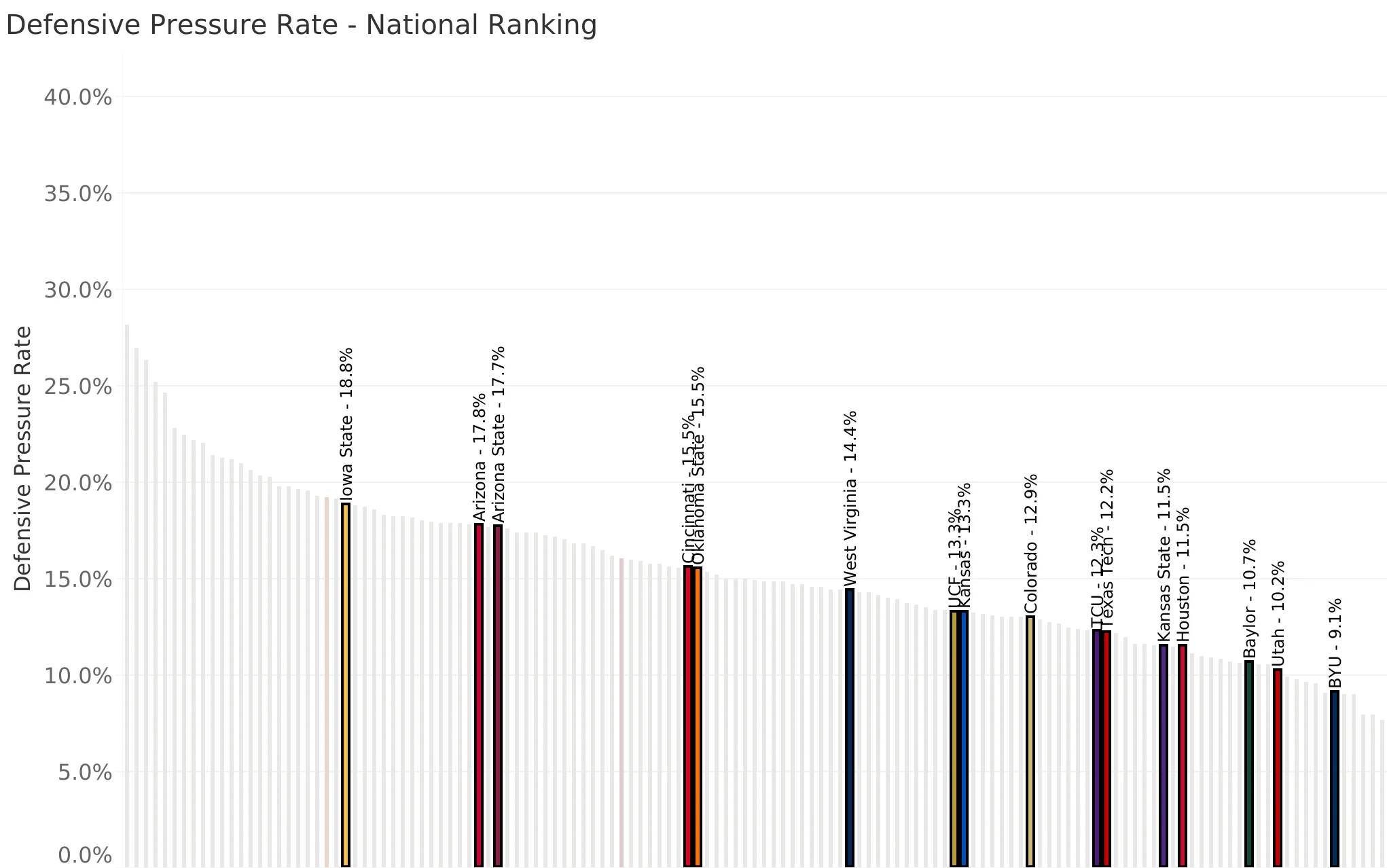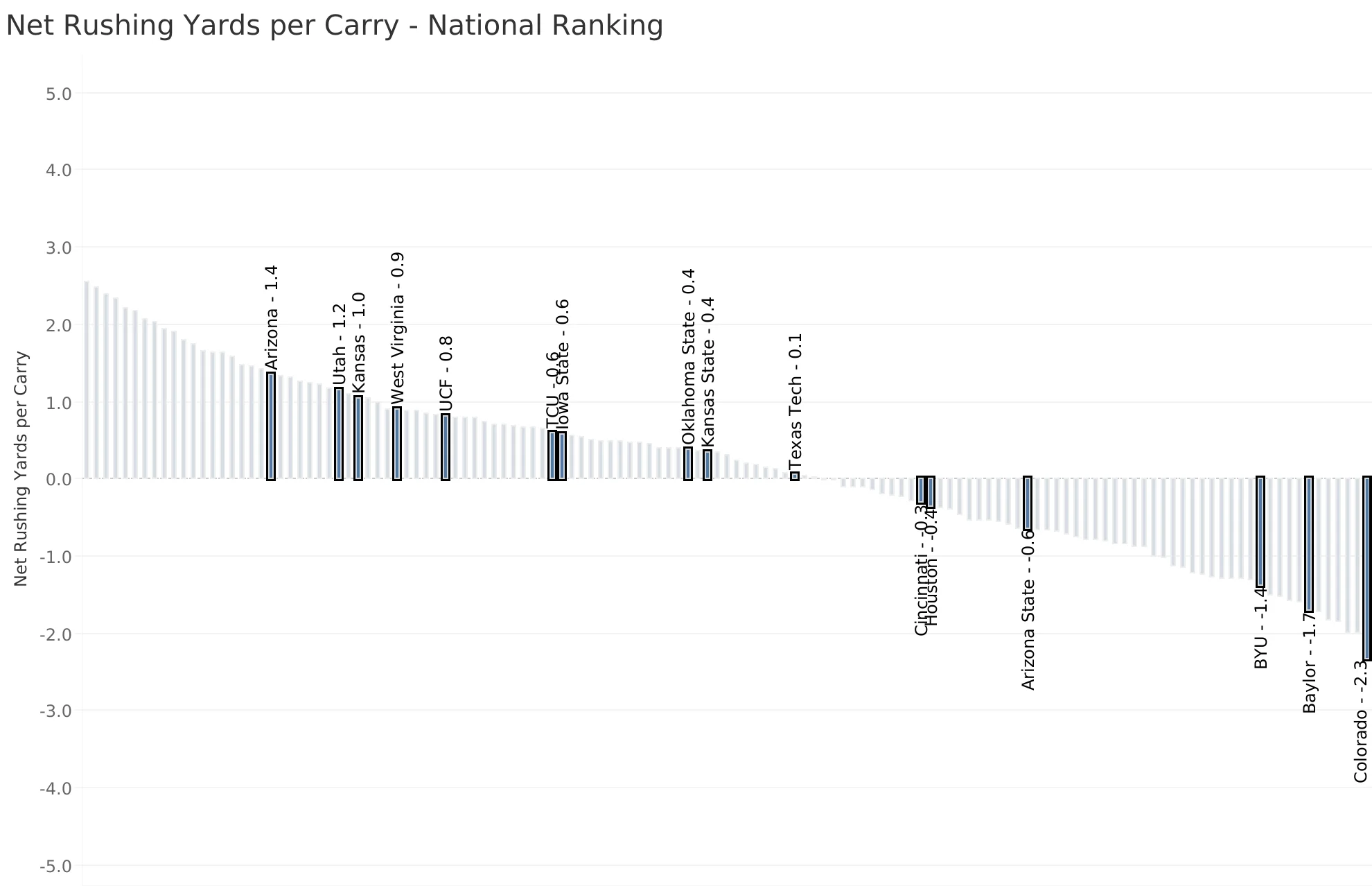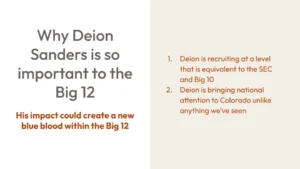The Colorado Buffaloes in 2024 are a hot topic in the college football world, which is a stark contrast to where they were two years ago at this point. In 2022, Colorado was heading into an abysmal 2022 season, at the end of which Deion Sanders was brought in to raise the program back from the grave in which it sat for the past 20 years. As I’ve been pouring through data for my Big 12 season predictions series, I’ve noticed some themes for Colorado that Buff fans will be aware of but want to forget. Today, I’m putting forward 3 ways in which the Buffaloes need to improve in order to get closer to a bowl game than further away.
Before I dig in, if you’re curious to know, I predicted that Colorado would finish with a 7-5 record. Taking that 1-11 team and turning it around to a 7-5 team in two years would be miraculous. After a 4-8 record in the 2023 season, people are generally predicting either doom (think 3-9) or boom (think Big 12 title) for the Buffs. If Deion remains there for the next several years, then I believe they will be in the College Football Playoff in time. It’s not a matter of if, but when he gets in.
So, let’s jump into the 3 areas in which Colorado can (and needs) to improve in 2024:
- Protect the quarterback
- Improve the defensive line
- Dramatically improve the rushing game (and rush defense)
All three of these focus on improving at the line of scrimmage on both sides of the ball. Going into 2023, Colorado significantly upgraded talent at the skill positions and other key positions (see Travis Hunter, Xavier Weaver, Shadeur Sanders). Now, going into 2024, the line of scrimmage needs dramatic improvement.
And, if you are wondering if they will be improved, then my answer is: we’ll have to watch and see, but the coaching staff certainly went after that position in recruiting. Look at this breakdown of Colorado’s recruiting efforts in 2024:
| Position | # of High School Recruits | # of Transfer Portal Recruits | Avg 247 Rating |
| Offensive Line | 2 | 5 | 89.5 |
| Defensive Line | 2 | 8 | 88.4 |
Deion and his staff brought in 35 new players for the Buffaloes. Almost 50% of those players were either on the offensive or defensive line. Does this mean that Colorado will improve? Again, as I said, we’ll wait and see. But first, let’s talk about where they need to improve.
Improvement #1 – Protect the Quarterback
I want you to remember a number. That number is 56. Repeat it in your head. Those of you who are stats Buffs (see what I did there…?) will already know what that number is in reference to.
Now, you may have already inferred why I want you to remember that number. But, before we dive into that number, let me ask you a few questions:
- How many games did you watch from Colorado last year (whether live or replay)?
- If so, did you notice how often Shadeur Sanders was put in the blender? (i.e. scramble for his life)
Sanders looked ragged at times. He was evasive, but he wants to pass. He is a pocket passer by nature. The team had dynamic receivers (and they’ve recruited more) and he wants to reach them. He’s not typically a tuck and run player nor is he a true dual threat quarterback.
This is how Colorado wants to play with him. Give Shadeur time to work, and he’ll find the right guy. When given time, his delivery is beautiful and he is very accurate. And, even when the building was on fire, which it was most games, he still managed to avoid turnovers. He had a 9:1 TD to INT ratio! That is incredible.
Alright, are you still remembering the number 56? Guess how many sacks the Colorado offensive line gave up in 2023? Yes, 56 sacks. 56!
That was good enough, or bad enough, for 2nd worst in the country. That is over 4 sacks per game. He was sacked on nearly 10% of their pass attempt plays.
Think about that – you’re sacked on nearly 1 in 10 plays. That is getting sacked almost every 3rd or 4th drive.
Sacks will kill drives. Most teams get between 11-13 drives per game. At 4+ sacks per game, they are essentially forfeiting 30-40% of their drives per game. Even if they do manage to convert a first down after a sack, they are essentially saying, “Alright, we’re going to play this drive with 200 lb sand bags strapped to our backs and 50 lb weights tied to our ankles because why not! We can do this!”
There were only 3 games in which the Buffaloes allowed less than 4 sacks. There was one game in which they allowed 8 sacks (amazingly, they beat Nebraska in that game)!

Data from @cfbfastR
Net Sacks
One other angle to look at with sacks is net sacks. This bleeds into Improvement Area #2 to a degree. When you look at net sacks (which is Sacks minus Sacks Allowed), Colorado did not perform very well. That is in large part due to their atrocious performance on the offensive side of the ball.
Colorado finished 131st in the country and last in the new Big 12 with a -28 net sacks. They generated 28 sacks but they allowed 56 sacks. I recognize that the defensive side of the ball is not also playing offense. But, this speaks to an overall culture of toughness, or lack thereof.
I don’t mean to infer that these guys are not tough relative to the average human being. No, they are quite tough. They are tougher than I am. But, relative to other college football teams, Colorado needs to get much tougher.

Data from @cfbfastR
Improvement #2 – Improve the Defensive Line
I cited the statistic of 28 sacks that Colorado generated in 2023. That was good for 47th best in the country and 4th best in the new Big 12. Not bad! That is definitely something to build on and continue.
28 is great, though there is still room to improve. Utah was best in the new Big 12 (33 sacks), and Penn State led the country with 49 sacks. So, if you’re the defensive coordinator, Robert Livingston, you would certainly love to increase that sack output.
However, there are a couple other areas that I would first address if I were consulting to him.
The first area is defensive success rate.
Defensive Success Rate
“What is defensive success rate?” you ask. It’s both simple and complicated. In its simplest expression, it measures how well a defense prevents an offense from being “on schedule” to getting a first down.
The more nuanced way to explain the metric is that each play is considered a success if it matches one of the following:
- On 1st down, the offense gains 50% of the yards to go to first down
- On 2nd down, the offense gains 70% of the yards to go to first down
- On 3rd down, the offense gains 100% of the yards to go to first down
- On any down, the offense scores
An example:
- 1st and 10 and the offense gains 6 yards = Success
- 2nd and 4 and the offense gains 1 yard = Not a Success
- 3rd and 3 and the offense gains 4 yards and gets the first down = Success
So, Defensive Success Rate measures the rate at which the defense prevents these type of success plays. The higher the rate, the worse the defense performed. The higher the rate, the more the defense struggled at preventing teams from picking up first downs or making highly gainful plays that would put them in 2nd and short or 3rd and short situations.
How did Colorado fare in 2023? Not great.
They had a 47.0% defensive success rate, which was good for 7th worst in the country. They were also the worst in the new Big 12. How far do they have to go to be at the best?

Data from @cfbfastR
To be best in the new Big 12, they would need to improve by over 11% points. Utah was the best at 35.8%. To be best in the country, they would need to improve by nearly 19% points. Penn State was the best at 29.5%.
If you are still skeptical about this metric, then consider which schools comprised the top 15 in defensive success rate in 2023:
| Ranking (top 15 rated in country in 2023) | School | Defensive Success Rate |
| 1 | Penn State | 29.5% |
| 2 | James Madison | 32.8% |
| 3 | Clemson | 33.0% |
| 4 | SMU | 33.7% |
| 5 | Iowa | 33.9% |
| 6 | Notre Dame | 34.0% |
| 7 | Alabama | 34.2% |
| 8 | East Carolina | 34.3% |
| 9 | Ohio | 34.5% |
| 10 | Michigan | 34.6% |
| 11 | Texas A&M | 34.7% |
| 12 | Florida State | 34.8% |
| 13 | Jacksonville State | 35.0% |
| 14 | Louisville | 35.2% |
| 15 | Ohio State | 35.5% |
How much better does Colorado need to get? They may not have to improve dramatically, assuming Pat Shurmur and the offense improve quarterback protection and the run game (see Improvement Area #3). I would aim for the low 40s as a starting place.
Defensive Pressure Rate
For a second area of defensive improvement, I would look at improving the defensive pressure rate. This is the second metric I’m discussing that is not typically found in a traditional box score. This metric is a bit more intuitive.
The metric is as follows:
(Sacks + QB Hurries) / Defended Pass Attempts
In plain english, it measures the percentage of passes you defend where you applied pressure to the quarterback in the form of a sack or a QB hurry.
How did Colorado fare? They weren’t as bad in this category as in other categories.
They had a 12.9% defensive pressure rate. For reference, that was 96th best in the country and 9th best in the new Big 12.
Iowa State led the Big 12 with an 18.8% defensive pressure rate, and Penn State led the country with a 28.2% defensive pressure rate.

Data from @cfbfastR
Why should they put some focus here? They are investing in the defensive line position right now (did you notice that they brought in 8 transfer portal recruits at that position?). When you look at the importance of the line of scrimmage and consider how Michigan just won the national title, you note that having a strong defensive line is part of a winning equation.
I wrote about some of my thoughts on the importance of the line of scrimmage after watching Michigan and their defensive front dominate the CFP this past season. For big-time success, you need to have a big-time defensive front. Therefore, any metric that begins with the defensive front needs to be measured and monitored.
While coordinators can certainly bring linebackers or DBs to pressure the quarterback, when a team can rely firstly on the defensive line, then the team has that many more layers of coverage. Linebackers can drop into coverage or spy the quarterback.
Improvement #3 – Dramatically Improve the Rushing Game (including rush defense)
Let me throw a few more metrics your way:
- Colorado’s Net Rushing performance in 2023
- 2.3 yards per carry which was worst in the new Big 12
- 4.6 yards per carry allowed which was tied for 11th worst in the new Big 12
- Negative net rushing yards of 2.3 per carry. Worst in the country and in the Big 12.

Data from @cfbfastR
This will be evident to all Colorado fans who watched the season. Dylan Edwards made a splash in Week 1 against TCU, scoring 1 touchdown on the ground (and 3 through the air). However, he didn’t score a single rushing touchdown the rest of the season.
He was the leading rusher, but only had 321 yards on the season. The next best back, Anthony Hankerson, rushed for 319 yards and had 4 TDs.
The fact that no Colorado Buffaloes running back went for over 350 yards is a problem. That the two combined went for barely 650 is also problematic.
How can they improve the rush game?
I’ll come back to the offensive line. The rush game almost always starts there. This offensive line is turning over again. The recruits that the coaching staff brought in (through portal and HS) come in with a really good rating per 247. That doesn’t guarantee wins, but it is a good place to start.
The challenge that I foresee this year, though, is that offensive line gelling together. Teams across the country are learning the difficulties of portaling in an offensive line. Offensive lines take time to build cohesion. No other position group requires so much communication with so many interconnected players.
As to the running back position, Deion and crew brought in one running back from high school (Micah Welch) but has not yet brought in a running back via the portal. So, whoever is going to be a feature back is going to need to come from the roster as it currently stands.
Alton McCaskill brought a good season at Houston (in 2021) with him when he transferred in last year. Yet, he barely saw the field in 2023. Does Dylan Edwards make a huge jump in 2024?
The importance of improving the running game is only going to help take pressure off of Shadeur. If the running game improves to close to 4 yards per carry, then there is a real world where Shadeur throws for over 4,000 yards.
A Final Thought
Colorado continues an historic climb from what was a difficult 2022 season. And, when you zoom out further, the past ~20+ years have generally not been as bright as what the next few years could be. To those who believe in Colorado and Coach Prime, I’d encourage patience through some of the ups and downs this year that I expect Colorado to go through. Deion is literally rebuilding something from the ground up.
I expect Colorado to be a Big 12 contender under Coach Prime for the next decade (if he stays that long), though I don’t expect it this year.
To those who do not believe in what is happening in Boulder, I’d encourage you to look at what happened to Jackson State and to what Deion did between 2022 and 2023.
If you take out the Oregon and Washington State losses, then Colorado’s other six losses were by a combined 38 points, which is just about a touchdown per game. They were on the cusp of winning more games than they lost.
I don’t expect Colorado to be special…yet. But, if Deion stays around, then you are going to start to hear them in conversations around the CFP on a regular basis.
About 3rd Down Analysis (3DA): With a goal of fueling fan’s college football passion, 3rd Down Analysis brings an important combination of understanding the game of football while also knowing how to interpret what the data are telling us. Through long-form content, 3DA achieves this goal by dissecting data that is not easily accessible to fans and then sharing the bigger themes that are playing out on the field. Additionally, the business and financial background of the creator enables 3DA to share a unique viewpoint on the broader themes playing out across the college football landscape.
3rd Down Analysis has three primary content focus areas:
- BYU
- Big 12
- Current College Football big picture topics
If you have feedback, questions, content suggestions, or want to contribute, reach out to support@3rddownanalysis.com.
You can also search for the 3rd Down Analysis Podcast on Youtube, Apple Podcasts, or Spotify.





